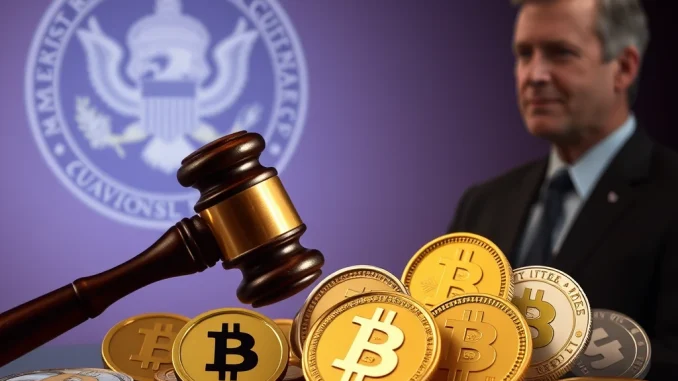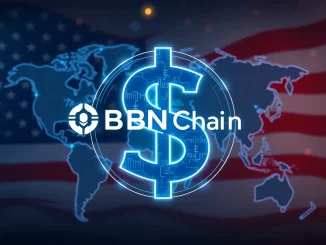
The cryptocurrency world is bracing for potentially seismic shifts in U.S. regulation. If Paul Atkins, a name synonymous with market expertise, steps into the chair’s seat at the Securities and Exchange Commission (SEC), insiders predict a complete overhaul of the current SEC crypto regulation framework. John Reed Stark, former SEC internet enforcement chief, suggests Atkins’ confirmation could trigger a dramatic reversal of policies enacted under Gary Gensler, potentially reshaping the entire digital asset landscape. Are we on the cusp of a regulatory revolution? Let’s delve into what this could mean for the future of crypto.
Will Paul Atkins Become the Next SEC Chair and Rewrite Crypto Regulation?
The buzz around Paul Atkins isn’t just speculative chatter; it’s fueled by his deep understanding of financial markets and a perceived pro-crypto stance. While the official nomination and confirmation process is still awaited, the mere possibility of Atkins leading the SEC has sparked intense debate and anticipation within the crypto community. Why is this potential appointment causing such ripples?
- A Departure from Gensler’s Approach: Gary Gensler’s tenure at the SEC was marked by a perceived crackdown on crypto firms, often characterized as regulation by enforcement. Atkins is expected to adopt a more industry-friendly approach, potentially focusing on clearer guidelines and fostering innovation rather than immediate enforcement actions.
- Industry Expertise: Atkins brings a wealth of experience, having served as an SEC Commissioner himself. This insider knowledge could translate to a more nuanced and practical understanding of the complexities of the crypto space.
- Fairness and Transparency: Even critics like John Reed Stark acknowledge Atkins’ integrity and commitment to fairness. This suggests a regulatory environment that, while potentially more lenient, would still operate with transparency and due process.
Decoding the Potential for a New Crypto Regulatory Framework
John Reed Stark’s prediction of 12 unprecedented reforms within Atkins’ first 100 days paints a picture of rapid and significant change. What could these reforms potentially entail, and how might they reshape the crypto regulatory framework?
| Potential Reform Area | Possible Changes Under Atkins | Impact on Crypto Industry |
|---|---|---|
| Security vs. Utility Token Classification | Clarity on distinguishing between securities and utility tokens, potentially reducing ambiguity and enforcement risks. | Greater legal certainty for token issuers and exchanges, fostering innovation and investment. |
| Regulation of Crypto Exchanges | Streamlined registration processes for crypto exchanges, moving away from overly burdensome requirements. | Easier market entry for compliant exchanges, potentially increasing competition and investor access. |
| Decentralized Finance (DeFi) Regulation | Development of tailored regulatory frameworks for DeFi, acknowledging its unique decentralized nature. | Reduced risk of blanket bans or stifling regulations on DeFi innovation. |
| Stablecoin Regulation | Clearer guidelines for stablecoin issuers, focusing on reserves and consumer protection without hindering innovation. | Increased stability and trust in stablecoins, facilitating wider adoption. |
| Enforcement Approach | Shift towards proactive guidance and dialogue with the industry, rather than solely relying on enforcement actions. | Improved industry-regulator relations, fostering collaboration and compliance. |
Analyzing Gary Gensler’s Crypto Policy and the Expected Shift
To understand the magnitude of the potential shift under Atkins, it’s crucial to reflect on Gary Gensler crypto policy. Gensler’s SEC adopted a firm stance, asserting broad jurisdiction over crypto assets and aggressively pursuing enforcement actions against firms deemed non-compliant. This approach, while aimed at investor protection, was criticized by some for stifling innovation and creating regulatory uncertainty.
Key aspects of Gensler’s policy that Atkins might reconsider include:
- Broad Definition of Securities: Gensler’s SEC often interpreted a wide range of crypto assets as securities, subjecting them to stringent securities laws. Atkins might advocate for a narrower definition, particularly for utility tokens.
- Regulation by Enforcement: The SEC under Gensler frequently used enforcement actions as its primary regulatory tool. Atkins could favor a more proactive approach, issuing clearer guidelines and engaging in dialogue with the industry.
- Focus on Investor Protection through Strict Enforcement: While investor protection remains paramount, Atkins might seek a balance between protection and fostering innovation, potentially through less aggressive enforcement and more emphasis on compliance guidance.
The Stance of John Reed Stark: A Critical Yet Respectful Perspective
John Reed Stark’s commentary provides a balanced perspective. While critical of Atkins’ anticipated pro-crypto stance, Stark acknowledges Atkins as an “honorable individual” committed to fairness and transparency. This nuanced view suggests that even those who anticipate a shift in SEC reforms under Atkins recognize his integrity and dedication to a fair regulatory process. Stark’s expectation of 12 reforms in the first 100 days underscores the potential for rapid and significant changes, regardless of one’s perspective on their desirability.
What Does a Pro-Crypto SEC Chair Mean for the Future?
The potential appointment of Paul Atkins as Paul Atkins SEC chair signals a possible paradigm shift in U.S. crypto regulation. A more industry-friendly SEC chair could lead to:
- Increased Institutional Investment: Clearer regulations and a less enforcement-heavy approach could attract more institutional investors to the crypto market.
- Innovation and Growth: A supportive regulatory environment can foster innovation, allowing crypto businesses to thrive and develop new technologies.
- Global Competitiveness: A more progressive regulatory framework could enhance the U.S.’s competitiveness in the global crypto landscape, attracting talent and investment.
- Market Maturity: Balanced and well-defined regulations can contribute to the overall maturity and stability of the crypto market.
However, it’s crucial to acknowledge potential challenges. A perceived softening of regulation could raise concerns about investor protection and market integrity. The key lies in finding a balance – creating a regulatory environment that fosters innovation while safeguarding investors and ensuring market stability. The coming months will be pivotal in determining the direction of U.S. crypto regulation and the impact of Paul Atkins’ potential leadership at the SEC.
Conclusion: Navigating the Winds of Change in Crypto Regulation
The prospect of Paul Atkins leading the SEC and potentially rewriting the crypto rulebook is a watershed moment for the digital asset industry. While uncertainty remains, the anticipation of significant regulatory reforms is palpable. Whether these changes will usher in a new era of crypto growth or present unforeseen challenges remains to be seen. One thing is clear: the crypto world is watching closely, poised to adapt and evolve as the regulatory landscape potentially undergoes a dramatic transformation under a new SEC leadership.



